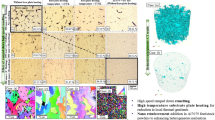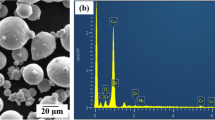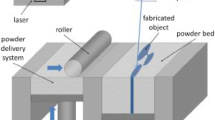Abstract
Although additive manufacturing (AM) technologies have been rarely used to produce lead-containing brass, the same AM technologies have never been adopted to produce lead-free brass parts based on the CuZn42 alloy. This study aims to fill the gap, demonstrating the feasibility of lead-free brass alloys by laser powder bed fusion (LPBF) technology and investigating structural and mechanical properties of the produced specimens, focusing attention on the role of surface energy density on material properties. Starting from a raw powder of CuZn42 alloy containing α, β and γ brass phases, fully dense samples with high hardness values were obtained by LPBF. The structural and mechanical properties of the samples were investigated by scanning electron microscopy (SEM), energy-dispersive microanalysis (EDS), X-ray diffraction (XRD) and density and hardness measurements. Results showed that density, hardness and the relative amount of the brass phases depend on the surface energy density (SED) Es. The investigated range of SED allowed defining the process window ranging from 2 J/mm2 to 10 J/mm2, within which fully dense samples can be obtained. A linear dependence of hardness on density was also found, suggesting that deformation mechanisms are mainly due to the presence of residual pores and internal cavities rather than to microstructural features, such as the relative amount of brass phases and crystallographic defects. All results obtained in this work demonstrated, for the first time, that LPBF is suitable to produce components based on the CuZn42 alloy, and that structural and mechanical properties of the produced parts can be properly designed by controlling SED.








Similar content being viewed by others
References
Li S, Kondoh K, Imai H, Atsumi H (2011) Fabrication and properties of lead-free machinable brass with Ti additive by powder metallurgy. Powder Technol 205(1–3):242–249. https://doi.org/10.1016/j.powtec.2010.09.020
Vilarinho C, Davimb JP, Soares D, Castro F, Barbosa J (2005) Influence of the chemical composition on the machinability of brasses. J Mater Process Technol 170:441–447
Toulfatzis AI, Pantazopoulos GA, Paipetis AS (2014) Fracture behavior and characterization of lead-free brass alloys for machining applications. J Mater Eng Perform 23(9):3193–3206. https://doi.org/10.1007/s11665-014-1096-3
Acceptance Of metallic materials used for products in contact with drinking water, procedure for the acceptance of metallic materials for PDW, 12th Revision 14.10.2019.
NSF 372 – Drinking water system components, lead content, http://www.nsf.org/newsroom_pdf/nsf61-372_lead_insert_LWD-1350-0513.pdf.
Stwora A, Skrabalak G (2013) Influence of selected parameters of selective laser sintering process on properties of sintered materials. J Achiev Mater Manuf Eng 61(2):375–380
Yang C, Zhao YJ, Kang LM, Li DD, Zhang WW, Zhang LC (2018) High-strength silicon brass manufactured by selective laser melting. Mater Lett 210:169–172. https://doi.org/10.1016/j.matlet.2017.09.011
Zhang S, Zhu H, Hu Z, Zeng X, Zhong F (2019) Selective laser melting of Cu10Zn alloy powder using high laser power. Powder Technol 342:613–620. https://doi.org/10.1016/j.powtec.2018.10.002
Popovich A, Sufiiarov V, Polozov I, Borisov E, Masaylo D, Orlov A (2016) Microstructure and mechanical properties of additive manufactured copper alloy. Mater Lett 179:38–41. https://doi.org/10.1016/j.matlet.2016.05.064
Huang CJ, Wu HJ, Xie YC, Li WY, Verdy C, Planche MP, Liao HL, Montavon G (2019) Advanced brass-based composites via cold-spray additive-manufacturing and its potential in component repairing. Surf Coat Technol 371:211–223. https://doi.org/10.1016/j.surfcoat.2019.02.034
Szakál Z, Kári-Horváth A, Pataki T, Odrobina M (2019) The Mechanical properties of 3D printed CuZn28 brass specimens with different orientations. Inter J Eng Manag Sci 4(1):253–259. https://doi.org/10.21791/IJEMS.2019.1.32
Manakari V, Parande G, Gupta M (2017) Selective laser melting of magnesium and magnesium alloy powders: a review. Metals 7(1):2. https://doi.org/10.3390/met7010002
Bourell D, Kruth JP, Leu M, Levy G, Rosen D, Beese AM, Clare A (2017) Materials for additive manufacturing. CIRP Ann 66(2):659–681. https://doi.org/10.1016/j.cirp.2017.05.009
Zhang Y, Zhang J (2019) Modeling of solidification microstructure evolution in laser powder bed fusion fabricated 316L stainless steel using combined computational fluid dynamics and cellular automata. Addit Manuf 28:750–765. https://doi.org/10.1016/j.addma.2019.06.024
Khorasani AM, Gibson I, Ghasemi A, Ghaderi A (2019) A comprehensive study on variability of relative density in selective laser melting of Ti-6Al-4V. Virtual and Physical Prototyping 14(4):349–359. https://doi.org/10.1080/17452759.2019.1614198
Silbernagel C, Gargalis L, Ashcroft I, Hague R, Galea M, Dickens P (2019) Electrical resistivity of pure copper processed by medium-powered laser powder bed fusion additive manufacturing for use in electromagnetic applications. Addit Manuf 29:100831. https://doi.org/10.1016/j.addma.2019.100831
Klages K, Ruettimann C, Olowinsky A (2003) Laser beam micro welding of dissimilar metals. Inter Cong App Lasers Electro-Optics Laser Inst Am. https://doi.org/10.2351/1.5060103
K. Klages, J. Gedicke, A. Olowinsky, (2004) “Pulse forming at laser beam micro welding.” International Congress on Applications of Lasers and Electro-Optics Laser Institute of America https://doi.org/10.2351/1.5060336
A. Gillner, A. Olowinsky, K. Klages, J. Gedicke, F. Sari, (2006) “High-precision and high-speed laser microjoining for electronics and microsystems.” International Conference on Lasers, Applications, and Technologies 2005: Laser-Assisted Micro-and Nanotechnologies International Society for Optics and Photonics https://doi.org/10.1117/12.674979
Meran C (2006) The joint properties of brass plates by friction stir welding. Mater Des 27(9):719–726. https://doi.org/10.1016/j.matdes.2005.05.006Get
Hugger F, Hofmann K, Stein S, Schmidt M (2014) Laser beam welding of brass. Phys Procedia 56:576–581. https://doi.org/10.1016/j.phpro.2014.08.045
I. Yadroitsau, (2008) “Direct manufacturing of 3D objects by selective laser melting of metal powders.” Doctoral dissertation, Saint-Etienne
R. Zhao, C. Chen, W. Wang, T. Cao, S. Shuai, S. Xu, T. Hu, H. Liao, J. Wang, Z. Ren, (2022) “On the role of volumetric energy density in the microstructure and mechanical properties of laser powder bed fusion Ti-6Al-4V alloy.” Additive Manufacturing: 102605
Fathi-Hafshejani P, Soltani-Tehrani A, Shamsaei N, Mahjouri-Samani M (2022) Laser incidence angle influence on energy density variations, surface roughness, and porosity of additively manufactured parts. Addit Manuf 50:102572
Li G, Li X, Guo C, Zhou Y, Tan Q, Qu W, Li X, Hu X, Zhang M-X, Zhu Q (2022) Investigation into the effect of energy density on densification, surface roughness and loss of alloying elements of 7075 aluminium alloy processed by laser powder bed fusion. Opt Laser Technol 147:107621
Wang W, Shen J, Liu W, Bian H, Li Q (2022) Effect of laser energy density on surface physical characteristics and corrosion resistance of 7075 aluminum alloy in laser cleaning. Opt Laser Technol 148:107742
Wang L, Wei QS, Shi YS, Liu JH, He WT (2011) Experimental investigation into the single-track of selective laser melting of IN625. Adv Mater Res 233:2844–2848. https://doi.org/10.4028/www.scientific.net/AMR.233-235.2844
Yadroitsev I, Yadroitsava I, Bertrand P, Smurov I (2012) Factor analysis of selective laser melting process parameters and geometrical characteristics of synthesized single tracks. Rapid Prototyp J 18:201–208. https://doi.org/10.1108/13552541211218117
Campanelli SL, Casalino G, Contuzzi N, Angelastro A, Ludovico AD (2014) Analysis of the Molten/solidified Zone in Selective Laser Melted Parts. In High-Power Laser Mater Proces Lasers, Beam Deliv, Diagnostics, ApplicationsIII 10(1117/12):2042170
Ciurana J, Hernandez L, Delgado J (2013) Energy density analysis on single tracks formed by selective laser melting with CoCrMo powder material. Int J Adv Manuf Technol 68:1103–1110. https://doi.org/10.1007/s00170-013-4902-4
Gong H, Rafi K, Gu H, Janaki Ram GD, Starr T, Stucker B (2015) Influence of defects on mechanical properties of Ti–6Al–4V components produced by selective laser melting and electron beam melting. Mater Des 86:545–554. https://doi.org/10.1016/j.matdes.2015.07.147
Gong H, Rafi K, Gu H, Starr T, Stucker B (2014) Analysis of defect generation in Ti–6Al–4V partsmade using powder bed fusion additivemanufacturing processes. Addit Manuf 1–4:87–98. https://doi.org/10.1016/j.addma.2014.08.002
Bertoli US, Wolfer AJ, Matthews MJ, Delplanque JPR, Schoenung JM (2017) On the limitations of volumetric energy density as a design parameter for selective laser melting. Mater Des 113:331–340. https://doi.org/10.1016/j.matdes.2016.10.037
Zhao R, Chen C, Wang W, Cao T, Shuai S, Xu S, Hu T, Liao H, Wang J, Ren Z (2022) On the role of volumetric energy density in the microstructure and mechanical properties of laser powder bed fusion Ti-6Al-4V alloy. Addit Manuf. https://doi.org/10.1016/j.addma.2022.102605
ISO 13320:2009, Particle size analysis – Laser diffraction methods, International Organization for Standardization, 2009.
ASTM B213–17,(2017) Standard Test Methods for Flow Rate of Metal Powders Using the Hall Flowmeter Funnel, ASTM International, West Conshohocken, PA https://doi.org/10.1520/B0213-17.
ASTM B964–16, (2016) Standard Test Methods for Flow Rate of Metal Powders Using the Carney Funnel, ASTM International, West Conshohocken, PA: https://doi.org/10.1520/B0964-16.
Lutterotti L (2010) Total pattern fitting for the combined size–strain–stress–texture determination in thin film diffraction. Nucl Instrum Methods Phys Res, Sect B 268(3–4):334–340. https://doi.org/10.1016/j.nimb.2009.09.053
Mostafaei A, Zhao C, He Y, Ghiaasiaan SR, Shi B, Shao S, Shamsaei N, Wu Z, Kouraytem N, Sun T, Pauza J, Gordon JV, Webler B, Parab ND, Asherloo M, Guo Q, Chen L, Rollett AD (2022) Defects and anomalies in powder bed fusion metal additive manufacturing. Curr Opinion Solid State Mater Sci 26(2):100974
Gordon JV, Narra SP, Cunningham RW, Liu H, Chen H, Suter RM, Beuth JL, Rollett AD (2020) Defect structure process maps for laser powder bed fusion additive manufacturing. Addit Manuf 36:101552
Liu S, Shin YC (2019) Additive manufacturing of Ti6Al4V alloy: A review. Mater Des 164:107552. https://doi.org/10.1016/j.matdes.2018.107552
Kobryn PA, Semiatin SL (2001) The laser additive manufacture of Ti–6Al–4V. JOM 53:40–42. https://doi.org/10.1007/s11837-001-0068-x
Zheng H, Li H, Lang L, Gong S, Ge Y (2018) Effects of scan speed on vapor plume behavior and spatter generation in laser powder bed fusion additive manufacturing. J Manuf Process 36:60–67. https://doi.org/10.1016/j.jmapro.2018.09.011
D.Q. Zhang, Z.H. Liu, C.K. Chua, (2013) "Investigation on forming process of copper alloys via Selective Laser Melting." High Value Manufacturing: Advanced Research in Virtual and Rapid Prototyping: Proceedings of the 6th International Conference on Advanced Research in Virtual and Rapid Prototyping, Leiria, Portugal
Yin J, Zhang W, Ke L, Wei H, Wang D, Yang L, Zhu H, Dong P, Wang G, Zeng X (2021) Vaporization of alloying elements and explosion behavior during laser powder bed fusion of Cu–10Zn alloy. Int J Mach Tools Manuf 161:103686
Trapp J, Rubenchik AM, Guss G, Matthews MJ (2017) In situ absorptivity measurements of metallic powders during laser powder-bedfusion additive manufacturing. Appl Mater Today 9:341–349
Cunningham R, Zhao C, Parab N, Kantzos C, Pauza J, Fezzaa K, Sun T, Rollett AD (2019) Keyhole threshold and morphology in laser melting revealed by ultrahigh-speed x-ray imaging. Science 363:849–852
Rotty C, Mandroyan A, Doche ML, Hihn JY (2016) Electropolishing of CuZn brasses and 316L stainless steels: Influence of alloy composition or preparation process (ALM vs. standard method). Surf Coat Technol 307:125–135. https://doi.org/10.1016/j.surfcoat.2016.08.076
Acknowledgements
The authors acknowledge the technical support provided by 3d4mech SrL, Sasso Marconi, Bologna, Italy. This research was funded by 3d4mech SrL, Sasso Marconi, Bologna, Italy, and by Rubinetterie Bresciane Bonomi Spa, Via Massimo Bonomi, 1, 25064 Gussago BS.
Author information
Authors and Affiliations
Corresponding author
Additional information
Publisher's Note
Springer Nature remains neutral with regard to jurisdictional claims in published maps and institutional affiliations.
Rights and permissions
Springer Nature or its licensor (e.g. a society or other partner) holds exclusive rights to this article under a publishing agreement with the author(s) or other rightsholder(s); author self-archiving of the accepted manuscript version of this article is solely governed by the terms of such publishing agreement and applicable law.
About this article
Cite this article
Gatto, A., Gatto, M.L., Groppo, R. et al. Influence of laser powder bed fusion process parameters on the properties of CuZn42 components: case study of the laser surface energy density. Prog Addit Manuf 8, 843–855 (2023). https://doi.org/10.1007/s40964-022-00361-z
Received:
Accepted:
Published:
Issue Date:
DOI: https://doi.org/10.1007/s40964-022-00361-z




